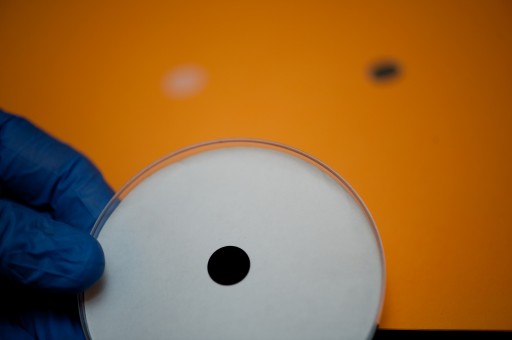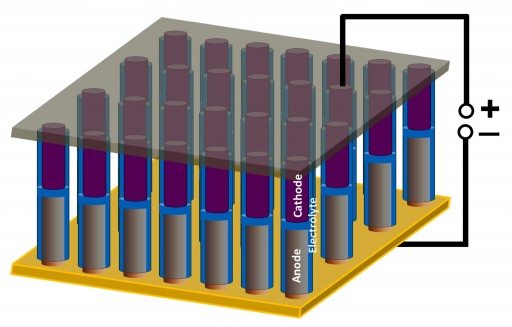Scientists build battery in a nanowire
August 1, 2011

An ultrathin battery/supercapacitor hybrid contains thousands of nanowires, each of which is a fully functional battery (credit: Jeff Fitlow/Rice University)
Researchers at Rice University have packed an entire lithium ion energy storage device into a single nanowire.
The researchers first reported the creation of three-dimensional nanobatteries last December. In that project, they encased vertical arrays of nickel-tin nanowires in PMMA (Plexiglas) that served as an electrolyte and insulator. They grew the nanowires via electrodeposition in an anodized alumina template atop a copper substrate.
In that battery, the encased nickel-tin was the anode, but the cathode had to be attached on the outside.
The new process tucks the cathode inside the nanowires, the researchers said. They used PEO as the gel-like electrolyte that stores lithium ions and also serves as an electrical insulator between nanowires in an array.

Nanoscale battery/supercapacitor devices in an array. The devices show promise for powering nanoscale electronics and as a research tool for understanding electrochemical phenomenon at the nanoscale (credit: Ajayan Lab/Rice University)
After much trial and error, they settled on an easily synthesized polymer known as polyaniline (PANI) as their cathode. Drop-coating the widened alumina pores with PEO coats the insides, encases the anodes and leaves tubes at the top into which PANI cathodes could also be drop-coated. An aluminum current collector placed on top of the array completes the circuit.
The experimental batteries are about 50 microns tall and show good capacity, the researchers said. They are fine-tuning the materials to increase their ability to repeatedly charge and discharge, which now drops off after a about 20 cycles.
Ref.: Sanketh R. Gowda, Building Energy Storage Device on a Single Nanowire, Nano Letters, 2011; [DOI:10.1021/nl2017042]